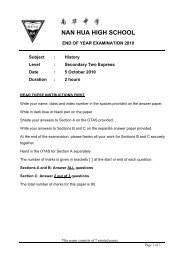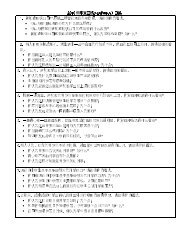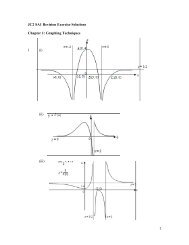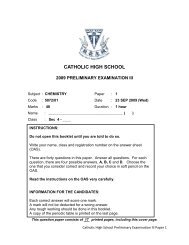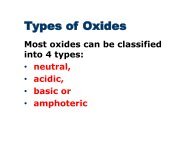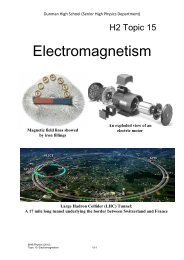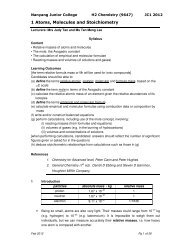POTENTIAL DIVIDER, THERMISTOR AND LDR ... - ASKnLearn
POTENTIAL DIVIDER, THERMISTOR AND LDR ... - ASKnLearn
POTENTIAL DIVIDER, THERMISTOR AND LDR ... - ASKnLearn
Create successful ePaper yourself
Turn your PDF publications into a flip-book with our unique Google optimized e-Paper software.
<strong>POTENTIAL</strong> <strong>DIVIDER</strong>, <strong>THERMISTOR</strong> <strong>AND</strong> <strong>LDR</strong><br />
LEVEL I<br />
1. A potential divider is constructed by a fixed resistor and an <strong>LDR</strong> as shown below.<br />
The resistance of the <strong>LDR</strong> is 9000 in the dark and 600 when exposed to light.<br />
(a)<br />
(b)<br />
(c)<br />
Calculate the potential difference between X and Y when the <strong>LDR</strong> is in the<br />
dark.<br />
Ans: 1.5 V<br />
In the dark, total resistance = 9000 Ω + 3000 Ω<br />
= 12000 Ω<br />
Current flowing, I dark = 6 V / 12000 Ω<br />
= 5.0 x 10 -4 A<br />
V xy = ( 5.0 x 10 -4 A)(3000 Ω )<br />
= 1.5 V*<br />
*Use the potential<br />
divider equation<br />
( V= R 1 x E/(R 1 +R 2 )<br />
as an alternative.<br />
Calculate the potential difference between X and Y when the <strong>LDR</strong> is exposed<br />
to light.<br />
Ans: 5.0 V<br />
In bright light, total resistance = 600 Ω + 3000 Ω<br />
= 3600 Ω<br />
Current flowing, I dark = 6 V / 3600 Ω<br />
= 1/600 A<br />
V xy = ( 1/600 A)(3000 Ω )<br />
= 5.0 V*<br />
An LED is connected to X and Y as shown in the diagram below. State at<br />
what condition will the LED light up.<br />
When the level of brightness is high.( Explanation: When light intensity, R <strong>LDR</strong> ,<br />
V <strong>LDR</strong> , V XY . LED is forward-biased and the trigger voltage is small; the resistor<br />
in series with the LED will have a voltage close to V xy )<br />
49
LEVEL II<br />
2. In the circuit shown below, E is a battery of e.m.f. 6.0 V and of negligible internal<br />
resistance. R 1 and R 2 are two fixed resistors, each of resistance 150 , V 1 is a high<br />
resistance voltmeter and A is an ammeter of negligible resistance.<br />
(a) (i) Calculate are the ammeter reading and voltmeter readings when the<br />
positive terminal of the voltmeter is connected to F<br />
Ans: 0.02A, 6V<br />
Ammeter reading = 6.0V/300 Ω<br />
= 0.02 A<br />
Voltmeter reading = 0.02 A x 300 Ω<br />
= 6.0 V<br />
(ii) What are the corresponding ammeter and voltmeter readings when<br />
the positive terminal of the voltmeter is connected first to point G and<br />
then to point H Ans: G: 0.02A, 3V H: 0.02A, 0V<br />
At point G<br />
Ammeter reading = 0.02 A<br />
Voltmeter reading = 0.02 A x 150 Ω<br />
= 3.0 V<br />
At point H<br />
Ammeter Reading = 0.02 A<br />
Voltmeter = 0.0 V<br />
(since there are no potential<br />
difference at the same point)<br />
(b)<br />
The circuit is now changed by connecting a light-dependent resistor (<strong>LDR</strong>) in<br />
series with a fixed resistor of resistance 1200 as shown below. V 2 is<br />
another high resistance voltmeter.<br />
K<br />
50
When no light falls on the <strong>LDR</strong>, its resistance is 3600 . When the only light<br />
falling on the <strong>LDR</strong> comes from a small filament lamp placed 50 mm away, its<br />
resistance is 1200 .<br />
(i)<br />
It is known that the light intensity from the bulb, I, varies inversely as<br />
the square of the distance, d. Sketch, on the axis given, the<br />
relationship stated above. How would the resistance of the <strong>LDR</strong> varies<br />
with the distance from the filament lamp<br />
I<br />
Intensity, I 1/d 2 I = k 1/d 2<br />
For the <strong>LDR</strong>, the resistance<br />
varies with the intensity I.<br />
R 1/I n<br />
where n is an<br />
interger R = k 2/I n … (2)<br />
Substitute I = k 1/d 2 into (2)<br />
R = k 2/(k 1/d 2 ) n = k 2x d 2n /(k 1) n<br />
= K x d 2n<br />
R d 2n<br />
0<br />
d<br />
(ii)<br />
(iii)<br />
(iv)<br />
Calculate the ammeter, A and voltmeter, V 2 readings when no light<br />
falls on the <strong>LDR</strong>.<br />
Ans: 0.021A, 4.5V<br />
Total resistance = 1200 Ω + 3600 Ω<br />
= 4800 Ω<br />
Ammeter reading = 6 V / total R ll<br />
= 0.021A<br />
Calculate the voltmeter, V 2 reading when light from the lamp falls on<br />
the <strong>LDR</strong>.<br />
Ans: 3.0V<br />
When light falls on the <strong>LDR</strong>,<br />
Ammeter reading = 6 V/1200Ω + 1200 Ω<br />
= 0.0025 A<br />
V 2 = 0.0025 A x 1200 Ω<br />
= 3.0 V*<br />
*Note that the answer can be obtained by stating that since both<br />
resistors are the same, the voltage of the supply is divided<br />
equally between the <strong>LDR</strong> and the 1200 Ω resistor<br />
A high resistance voltmeter is now connect across points G and K<br />
Calculate the voltmeter reading when light from the lamp falls on the<br />
<strong>LDR</strong>.<br />
Ans: 0.0 V<br />
The potential at G is the same as K There is thus no potential<br />
difference between the two points. Thus V 2 = 0.0 V<br />
51
3a. Figure below shows a d.c. series circuit. The e.m.f. of the battery is 12 V and the<br />
maximum resistance of the variable resistor is 75 .<br />
Determine,<br />
(i)<br />
the maximum and the minimum possible current through the circuit.<br />
Ans: 0.48A, 0.12A<br />
I max = 12 V / 25 Ω<br />
= 0.48 A<br />
I min = 12 V / (25Ω + 75 Ω )<br />
= 0.12 A<br />
(ii)<br />
(iii)<br />
the maximum and the minimum voltage across the 25 resistor.<br />
Ans: 12V, 3.0V<br />
V max = I max x 25 Ω<br />
= 0.48 A x 25 Ω<br />
= 12 V<br />
V min = I min x 25 Ω<br />
= 0.12 A x 25 Ω<br />
= 3.0 V<br />
the maximum power which can be dissipated in the 25 resistor.<br />
Ans: 5.76W<br />
P max = I max x V max<br />
= ( 0.48 A) ( 12 V)<br />
= 5.76 W<br />
= 5.8 W (2 s.f.)<br />
52
3b. The variable resistor in the above figure is then replaced by a thermistor. The<br />
graph below shows the relationship between the resistance of the thermistor and the<br />
temperature of the thermistor.<br />
The thermistor is placed first in pure melting ice and then in steam at standard<br />
atmospheric pressure. In each case the temperature of the thermistor is allowed to<br />
become constant.<br />
(i)<br />
State the resistances of the thermistor at the temperature of pure melting ice<br />
and at the temperature of steam<br />
R at 0 o C= 600 Ω<br />
R at 100 o C = 25 Ω<br />
(ii)<br />
State at what temperature does the resistance of the thermistor change most<br />
rapidly with temperature Give your reason for your answer.<br />
At 0 o C since the gradient ( dR/d) at that temperature is the highest<br />
(iii)<br />
What is the change in voltage across the thermistor as its temperature<br />
increases from the ice temperature to the steam temperature Show your<br />
working clearly. Ans: 5.52V<br />
At 0 o C, R total = 600 Ω + 25 Ω<br />
I at 0 o C = 12 V/625 Ω<br />
= 0.0192 A<br />
V thermistor = 0.0192 A x 600 Ω<br />
= 11.52 V<br />
At 100 o C, R total = 25 Ω + 25 Ω<br />
I at 100 o C = 12 V/50 Ω<br />
= 0.24 A<br />
V thermistor = 0.24 A x 25 Ω<br />
= 6.0 V<br />
Voltage change = 11.52 V – 6.0 V<br />
= 5.52 V<br />
= 5.5 V ( 2 s.f.)<br />
53




